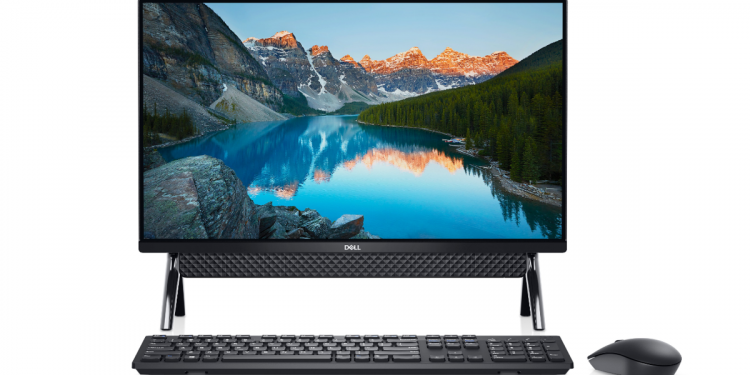Budget PCs are a balancing act, and the Dell Inspiron 24 5000 AIO balances—quite literally—on one of its weaker points. This budget all-in-one PC with a 24-inch display (starts at $579.99; $599.99 as tested) is perched on what Dell refers to as a “bipod stand,” with a pair of rodlike legs at either end of the display. Alas, they restrict where you can position the PC on your desk.
More an impediment, though, is the system’s platter hard drive. Here in the era of the solid-state drive (SSD), our Inspiron 24 5000 tester feels sluggish during general use, despite some positive results on our content-creation benchmarks. The Asus M241 costs only $60 more and provides better bang for your all-in-one buck, while the more upscale HP Pavilion 24 All-in-One remains our favorite all-in-one under a grand.
Stand Aside
Dell sells nine different models of the Dell Inspiron 24 5000 AIO, with prices ranging from $549.99 to $1,179. Our review unit is one step up from the Pentium-based entry-level model. It features an 11th-generation Intel Core i3 mobile CPU, 8GB of RAM, and a 1TB, 7,200rpm SATA hard drive. It’s one of only two models in the line that lacks an SSD. You can skip to the benchmark results section to see how the mechanical hard drive held back our test system’s performance, but if you are looking for a quick takeaway, it’s this: Avoid any configuration that lacks a solid-state hard drive, if you can afford to.
It is not unusual to find a variety of component configurations in a computer series but rarely is more than one physical design offered within the same line. For the Inspiron 24 5000 AIO, however, Dell provides a choice of three designs. In addition to the bipod stand available on the lower-end models, there is also an “arch” stand and an “A-frame” stand.
In-person, I’ve only seen the bipod design. Judging from the images on Dell’s site, the arch and A-frame stands look more refined than the bipod stand of our test system. Made from molded, black plastic, the bipod stand features two sets of legs on either end of the display. It provides a sturdy base upon which the display rests. But the stand design lends more of a sawhorses-in-a-workshop vibe than that of an elegant desktop PC for your office or den.
The bipod base also limits where you can place the PC. With a pair of legs on either end of the display, you can’t position the chassis in the corner of your desk, because one or both sets of legs will jut off the edge. Also, the bipod stand offers tilt adjustment only.
The stand on our test model aside, the Inspiron 24 5000 has an attractive, space-saving design and solid build quality. Thin bezels frame the display for a pleasing, modern look, and a small speaker bar sits below the display. All the surfaces are black, for a simple, monochromatic look that makes the system look at home in a variety of locations, from the breakfast nook or bedroom to the reception area or boardroom.
The Inspiron 24 5000 on its bipod stand measures 16.3 by 21.2 by 7.6 inches (HWD), which is average for a 24-inch-screened all-in-one. In comparison, the Asus M241 measures 16.1 by 21.3 by 6.5 inches (HWD), and the HP Pavilion 24 All-in-One is 17.1 by 21.3 by 6.5 inches (HWD). The biggest difference among these three 24-inches is that Dell’s bipod base requires a bigger footprint.
All of the system’s ports are located in a row in the center of the back panel, and it’s a good mix. You get an HDMI-in and an HDMI-out port, a USB 3.1 Type-C (Gen 2) port, three USB 3.1 Type-A (Gen 1) ports, a USB 2.0 port, a headphone jack, an Ethernet jack, and an SD card reader. You also get the latest wireless standards, in the form of Wi-Fi 6 and Bluetooth 5.1.
The pair of HDMI ports is convenient, letting you connect a game console to the HDMI input, for example, or use the HDMI-out to output the video signal to your HDTV. Having at least one of both types of USB ports—A and C—means you can connect any USB device without needing to dig around your shelves or through drawers for an adapter.
Some Standout Speakers
The Inspiron 24 5000 is based on a 23.8-inch non-touch display with a full HD (1,920-by-1,080-pixel) resolution. I was not left wanting more pixels from the display; its image is sufficiently sharp across the 23.8-inch panel. Text, HD videos, and images looked crisp, and I didn’t see the pixelated screen-door effect unless I had my nose right up against the display. I was left wanting more brightness, however. In my north-facing office which doesn’t get much sunlight, I had the brightness setting at its maximum, and there were many points throughout the day where I wanted to raise the brightness more.
I was pleasantly surprised by the speakers’ output. Their sound more than filled my small office and produced a fairly dynamic sound with something approaching a bass response. The middle tones were a bit muddied, but the audio output sounded bright, with clear high tones. There was enough bass that music playback was enjoyable, which is not something that can be said about the audio on every AIO.
A 720p webcam hides in a pop-up panel above the display. The webcam’s picture will suffice for Zoom calls, but skin tones tended toward the red end of the spectrum (and I say this as a pale guy at the end of a long winter in northern New England). When it is not in use, you can push the webcam down to protect your privacy, an always-appreciated feature.
A wired keyboard and mouse come bundled with the Inspiron 24 5000. Both are serviceable, but a wireless pair would be preferable to cut down on wire clutter. Wireless peripherals are rarely on offer with a budget all-in-one, though.
Testing the Inspiron 24 5000: Multimedia Muscle, But Slow in the Real World
Our Inspiron 24 5000 test system features an 11th Generation Intel Core i3 CPU (the Core i3-1115G4), 8GB of RAM, and a 1TB Serial ATA hard drive that spins at 7,200rpm. The Core i3-1115G4 is a dual-core mobile processor with multi-threading support. It operates at a base frequency of 3GHz, with a boost frequency of 4.1GHz. While the system performed to expectations for a two-core/four-thread Core i3 in our benchmarks—particularly the multimedia tests—it often felt sluggish during regular Windows use, and the hard drive is the primary suspect. Traditional hard drives are much slower than solid-state drives, which the results of our PCMark 8 Storage test will reinforce. In real-world terms, I experienced frequent lag when performing simple tasks like launching an app, opening photos in the Photos app, and navigating Windows Explorer. (See more about how we test desktops.)
For our benchmarks, we compared the Inspiron 24 5000 against other budget all-in-ones. At the low end is the 21.5-inch HP All-in-One 22-dd0010, which features an underpowered AMD Athlon CPU and only 4GB of RAM. Closest to the Inspiron 24 in price and components is the AMD Ryzen 3-based Asus M241, while the Ryzen 5-based HP Pavilion 24-k0220z and Core i5-based MSI Pro 24X 10M are slightly more expensive and capable. (Particularly so the HP Pavilion 24, which is the only system of this lot to feature 16GB of RAM.)
Productivity, Storage, and Media Tests
PCMark 10 and 8 are holistic performance suites developed by the PC benchmark specialists at UL. The PCMark 10 test we run simulates different real-world productivity and content-creation workflows. We use it to assess overall system performance for office-centric tasks such as word processing, spreadsheet work, web browsing, and videoconferencing. The test generates a proprietary numeric score; higher numbers are better.
PCMark 8, meanwhile, has a Storage subtest that we use to assess the speed of the boot drive. This score is also a proprietary numeric score; again, higher numbers are better.
The Inspiron 24 5000 was able to run with the budget all-in-one pack on PCMark 10, finishing just behind the Ryzen 3-based Asus M241 and ahead of the Athlon-based HP All-in-One 22. The HP Pavilion 24 and its quad-core Ryzen 5, and the MSI Pro 24X 10M and its six-core Core i5, were the clear leaders.
The PCMark 8 Storage test is telling. The other systems feature solid-state drives and finished right around the 5,000 mark, while the Inspiron 24 5000 limped to a score of 1,571.
Next is Maxon’s CPU-crunching Cinebench R15 test, which is fully threaded to make use of all available processor cores and threads. Cinebench stresses the CPU rather than the GPU to render a complex image. The result is a proprietary score indicating a PC’s suitability for processor-intensive workloads.
The Inspiron 24 5000 finished in the middle of the pack on Cinebench. It topped its closest competitor in terms of components and cost, the Asus M241, but finished well off the pace of the MSI Pro 24X 10M and especially the leading HP Pavilion 24.
Cinebench is often a good predictor of our Handbrake video-editing trial, another tough, threaded workout that’s highly CPU-dependent and scales well with cores and threads. In it, we put a stopwatch on test systems as they transcode a standard 12-minute clip of 4K video (the open-source Blender demo movie Tears of SteelTears of Steel) to a 1080p MP4 file. It’s a timed test, and lower results are better.
The Inspiron 24 5000 also bested the Asus M241 on Handbrake and was only two minutes slower than the MSI Pro 24X 10M, indicating that it has some media-editing chops.
We also run a custom Adobe Photoshop image-editing benchmark. Using an early 2018 release of the Creative Cloud version of Photoshop, we apply a series of 10 complex filters and effects to a standard JPEG test image. We time each operation and, at the end, add up the total execution time. As with the Handbrake, lower times are better here. The Photoshop test stresses the CPU, storage subsystem, and RAM, but it can also take advantage of most GPUs to speed up the process of applying filters, so systems with powerful graphics chips or cards may see a boost.
The Inspiron 24 5000 saved its best performance for our Photoshop test, edging the MSI Pro 24X 10M and finishing only 6 seconds slower than the HP Pavilion 24. The high clock speed of its Core i3 processor relative to that of the other systems’ CPUs is likely the reason behind the Inspiron 24 5000’s success here.
Graphics Tests
3DMark measures relative graphics muscle by rendering sequences of highly detailed, gaming-style 3D graphics that emphasize particles and lighting. We run two different 3DMark subtests, Sky Diver and Fire Strike, which are suited to different types of systems. Both are DirectX 11 benchmarks, but Sky Diver is more suited to laptops and midrange PCs, while Fire Strike is more demanding and made for high-end PCs to strut their stuff. The results are proprietary scores.
I wouldn’t read too far into the Inspiron 24 5000’s second-place showing on our 3DMark tests. Its integrated Intel graphics severely limit any gaming ability for which you might wish.
Next up is another synthetic graphics test, this time from Unigine Corp. Like 3DMark, the Superposition test renders and pans through a detailed 3D scene and measures how the system copes. In this case, it’s rendered in the company’s eponymous Unigine engine, offering a different 3D workload scenario than 3DMark, for a second opinion on the machine’s graphical prowess. We present two Superposition results, run at the 720p Low and 1080p High presets.
The Inspiron 24 5000 did not produce playable frame rates on either Superposition test, lending further proof that this is not a system intended for 3D gaming.
Read Also: Discover the World of Desktop Wallpapers: A Complete Guide
Verdict: Serviceable, But Get an SSD
Given that Dell offers several versions of the Inspiron 24 5000, you’d be well served to look further up the line. In short: Do not be tempted by the roomy 1TB of storage space on our tester.
The penalty you pay for that capacious storage capacity in real-world performance and responsiveness is too great. Also worth noting: While it’s true that most of the Inspiron 24 5000 configurations that Dell offers feature speedy SSDs, at this writing the closest Inspiron 24 model to the Asus M241 cost $630, only $9 more than the Editors’ Choice-award-winning Asus. We favor the Asus M241 for its superior design, although the Inspiron 24 5000 does get some props for having a USB Type-C port and support for the latest wireless standards.
Source by in.pcmag.com














































